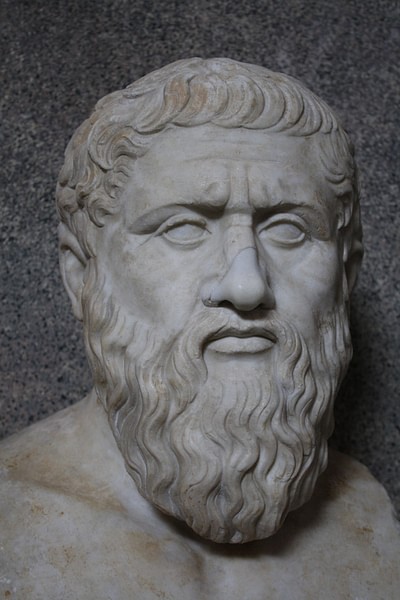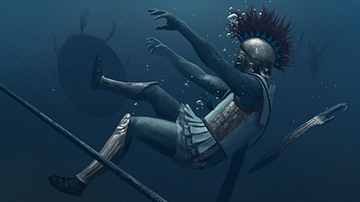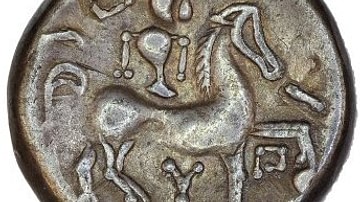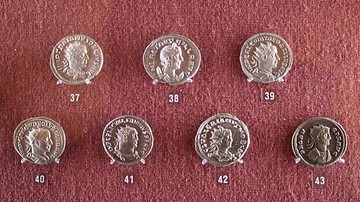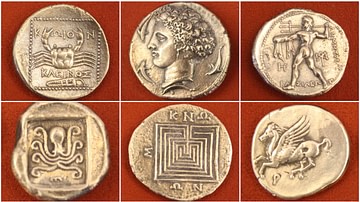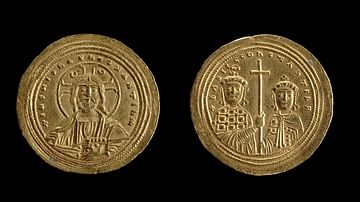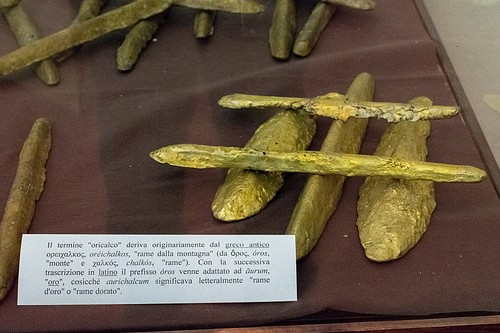
Orichalcum ("mountain copper") or aurichalcum ("gold copper") was a metal used in coins during ancient times. Orichalcum was a golden-yellow coloured mixture consisting of both copper and zinc and referred to as brass. The Romans were the first to make coins from orichalcum and were attracted to the metal due to its close resemblance to gold.
According to the Greek philosopher Plato (428/427-348-347 BCE), orichalcum was only second in value to gold. Ancient writers were at odds over whether or not orichalcum was a natural ore or made up of different metals.
Description & Etymology
Orichalcum was a metal that closely resembled gold, although its value was inferior. It was described as being the colour of fire, usually a dark yellow or a reddish-tinted yellow. Although ancient writers disagreed over the chemical makeup of orichalcum, modern studies have shown that most orichalcum was made up of 80% copper and 20% zinc, with small amounts of lead, tin, and other metals being detected. Orichalcum was malleable, stronger than copper, and resistant to tarnishing. According to the Roman orator and writer Cicero (106-43 BCE) in his De Officiis, gold and orichalcum were so close in appearance that many people easily mistook one for the other.
The word orichalcum derives from the Greek oros ("mountain") and chalkos ("copper" or "bronze"), thus the name "mountain copper". The Romans referred to orichalcum as aurichalcum, which derives from the Latin aurum ("gold").
History of Orichalcum
It is believed that the ancient Greeks knew about the existence of orichalcum before the Romans due to it being mentioned in ancient Greek literature by Homer (c. 750 BCE) and Hesiod (c. 700 BCE). Both seemed to hold the metal in high esteem. However, it was the Romans who first minted coins made of orichalcum, with the most common coins being the sestertius and the dupondius. The first orichalcum coins were minted in 45 BCE.
During his reign, Roman emperor Nero (r. 54-68 CE) had the three smaller denominations (semis, quadrans, and as) minted in orichalcum, although his reasoning for doing this is not entirely clear. The same was done by later emperors, Vespasian (r. 69-79 CE), Trajan (r. 98-117 CE) and Hadrian (r. 117-138 CE). Roman coinage minted from orichalcum was lighter and smaller in diameter than their copper counterparts and harder to come by.
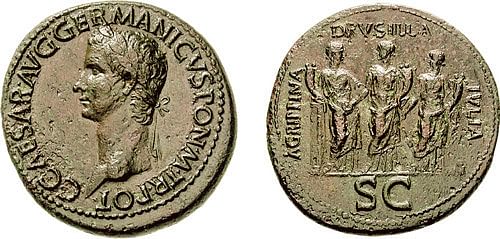
The manufacture of orichalcum had slowed down considerably after the reign of Emperor Antoninus Pius (r.. 138-161 CE) and especially during the reign of Emperors Marcus Aurelius (r. 161-180 CE) and Commodus (r. 180-192 CE). Numismatic and archaeological evidence has shown that orichalcum was mainly used to create coins and that its production was a state monopoly (the government was the sole provider of orichalcum). The few non-coin artefacts that were made from orichalcum were said to have a composition that was very similar to orichalcum coins; all the objects were small and weighed very little (no more than a sestertius). It is believed that these artefacts were made from melted-down orichalcum coins.
Some Romans (including well-known ones) took advantage of orichalcum's close resemblance to gold. Some questionable behaviours included people who could not help looting gold from temples and other public places and replacing the stolen gold with orichalcum. This included Julius Caesar (l. 100-44 BCE), who robbed 3,000 pounds (1,360 kg) of gold from the Roman Capitol (Capitoline Hill), and Emperor Vitellius (r. 69 CE), who followed suit by regularly despoiling temples and leaving orichalcum in their place.
Manufacturing Process
Although there is no surviving guide for how orichalcum was made, there have been some hints handed down from ancient writers, including Pliny the Elder (23-79 CE) in his Naural History and Pedanius Dioscorides (c. 40-90 CE) in his De materia medica, which suggest that a cementation process was required.
According to Pliny the Elder, orichalcum was created when copper was treated with a substance called cadmea (kadmeia in Greek). Cadmea consisted of two groups of metals; the first group included zinc minerals, namely smithsonite and calamine. In contrast, the second group consisted of artificial materials which were collected from the walls of smelting furnaces and sometimes prepared by cooking in a separate furnace. Cadmea always seemed to have taken the form of zinc oxide, which varied in purity and physical form. The natural cadmea was the type that was primarily used to treat copper to produce orichalcum.
In medieval and modern times, the cementation process included pieces of copper being buried in a mixture of zinc ore and charcoal in a crucible. When heated, the charcoal would reduce the zinc ore, and the liberated metal would form a vapour that the copper then absorbed.
The Romans carried out the cementation process a little differently. According to Pedanius Dioscorides, during the final treatment of copper, it was thrown on large amounts of finely ground cadmea to improve the quality of the metal. A reducing agent would also have needed to be added, which meant that charcoal and cadmea were stirred in molten copper. In addition, Dioscorides mentioned a fine white smoke that evolved during the treatment of copper. The quantity of the smoke was so great that it was collected from the walls of the melting furnace. This process of making orichalcum wasted the zinc ore and mineral, and the proportion of zinc in the finished product would have been difficult to control. Moreover, it was clear that the metalworkers during antiquity had no idea that zinc was alloyed with copper in the process and that the colour and other properties varied depending on the amount of zinc added.
The writings of Pliny the Elder and Dioscorides prove that they had no fundamental knowledge of the chemical changes involved in the treatment of copper with materials containing zinc. Pliny the Elder believed that the metal absorbed the cadmea, while Dioscorides was sure that the purpose of the process was to improve the quality of the copper.
During the reign of Emperor Nero, there was a decrease in zinc found in orichalcum coins. This is most likely a result of zinc minerals becoming increasingly harder to come by and more expensive to procure. Pliny the Elder also stated that orichalcum had eventually lost its value due to the mines becoming empty. Another possible explanation is that older coins were melted down so that the metal could be used to make new coins. Increasing amounts of lead and tin in orichalcum coins after the reign of Nero suggests that scrap bronze was being added to the manufacturing process, probably during the remelting of coins. This bronze was most likely from old Roman colonial coins.
The addition of bronze meant that most sestertii and dupondii coins were struck in bronze instead of orichalcum by the time Commodus was emperor of Rome. After his reign, orichalcum almost completely disappeared as a metal used to manufacture coins.
Orichalcum in Written Sources
One of the earliest mentions of orichalcum (sometimes translated to mountain copper) can be found in the Homeric Hymn to Aphrodite, dating to the 630s BCE, which detailed Aphrodite's beauty and the desire all immortal gods had for her.
On her immortal head
they laid a crown of gold
that was wonderfully made
and in
the pierced lobes of her ears
they hung
flowers of copper
from the mountains
and precious gold.(Homeric Hymn to Aphrodite, 6.6-9)
In Book 12 of the Aeneid by the Roman poet Virgil (70-19 BCE), Turnus, the legendary king of the Rutuli and the primary foe of Aeneas, wears a breastplate made of gold and white orichalcum (copper).
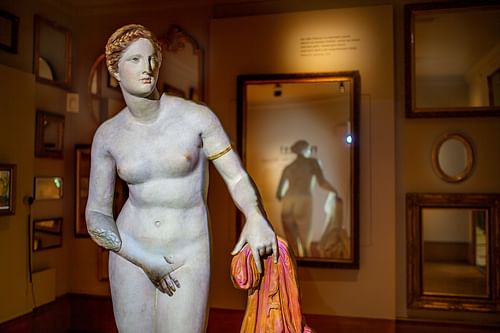
Atlantis
Orichalcum is frequently mentioned in Plato's Critias, in which he tells the story of the legendary lost continent of Atlantis. Plato claimed that orichalcum was mined in many parts of Atlantis and that its buildings, including the royal palace and the Temple of Poseidon, were covered with it, making them shine with a red light.
In the interior of the temple, the roof was of ivory, curiously wrought everywhere with gold and silver and orichalcum; and all the other parts, the walls and pillars and floor, they coated with orichalcum. (Plato, Critias, 116e)
Plato also claimed that the laws of Atlantis were given by Poseidon, which were then inscribed by the first kings of Atlantis on a pillar of orichalcum. Many believers and researchers of Atlantis search for orichalcum in the hopes that it would lead them to the fabled continent.
In 2015, believers of Atlantis were hopeful after a shipwreck carrying 47 ingots of orichalcum was found off the southern coast of Sicily. Another 39 bars were discovered in 2017. These ingots were believed to have been made around 2,600 years ago. They were covered in a blue and green patina (a thin layer that forms over certain metals) which revealed that there was copper present. Analysis showed that the ingots comprised 75-80% copper and 15-20% zinc with a mix of other metals, including nickel, lead and zinc. These finds confirmed that the ingots were definitely made of orichalcum. However, the truth about Atlantis remains elusive.

